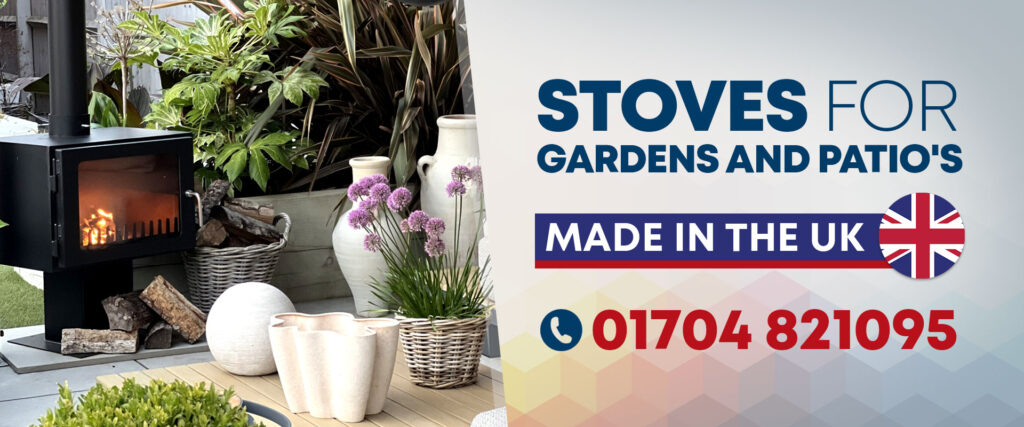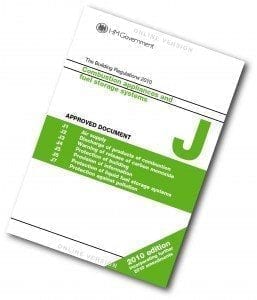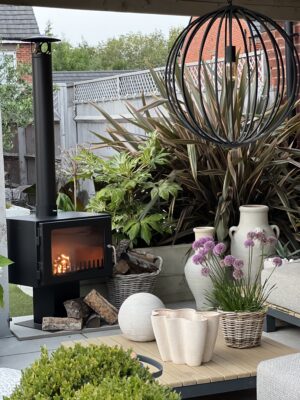
[metaslider id=2638]
Wood Burning Stove Regulations.
The aim of this post is to highlight some of the key issues that will affect the installation of your wood burning stove. Firstly here is a Wood Burning Stove Regulations of the full Document J of the building regulations.
Any chimney, flue liner, stove and other combustion appliance installation must comply with the legal requirements of the Building Regulations and the manufacture’s installation instructions. This is necessary to ensure the installation is safe and efficient. Failure to comply with the Regulations has many risks including a threat to life, property and prosecution. More details are given under Failure to comply with the Regulations section below.
If you are installing a new chimney you may need to check whether Planning permission is required. More information on this and the permitted development rights are explained under the Planning Permission section.
Before buying a wood burning stove you also need to check whether you are in a “Smoke Control” area in which case you will need an “exempt appliance” approved for burning wood in smoke control areas. For more details go the Smoke Control Areas section.
Hearths for wood and solid fuel burning appliances
A suitable non-combustible hearth of the right size and specification is required to protect any combustible material underneath and provide an area to catch any embers or burning fuel that might fall from the fire or stove. It is also meant to clearly show the area where combustible material such as carpet must not placed.
The Approved Document J gives the following guidance for hearths.
2.22Hearths should be constructed of suitably robust materials and to appropriate dimensions such that, in normal use, they prevent combustion appliances setting fire to the building fabric and furnishings, and they limit the risk of people being accidentally burnt. A way of making provision would adopt the guidance in Paragraphs 2.23 to 2.28 and to provide a hearth appropriate to the temperatures the appliance can create around it. The hearth should be able to accommodate the weight of the appliance and its chimney if the chimney is not independently supported.
2.23Appliances should stand wholly above:
- Hearths made of non-combustible board/sheet material or tiles at least 12mm thick, if the appliance is not to stand in an appliance recess and it has been independently certified that it cannot cause the temperature of the hearth to exceed 100ºC; or
- Constructional hearths in accordance with the paragraphs below.
2.24Constructional hearths should:
- Have plan dimensions as shown in Diagram 24; and
- Be made of solid, non-combustible material, such as concrete or masonry, at least 125mm thick, including the thickness of any non-combustible floor and/or decorative surface.
2.25 Combustible material should not be placed beneath constructional hearths unless there is an air-space of at least 50mm between the underside of the hearth and the combustible material, or the combustible material is at least 250mm below the top of the hearth (see Diagram 25).
2.26 An appliance should be located on a hearth so that it is surrounded by a surface free of combustible material as shown in Diagram 26. This surface may be part of the surface of the hearth provided in accordance with Paragraph 2.23, or it may be the surface of a superimposed hearth laid wholly or partly upon a constructional hearth. The edges of this surface should be marked to provide a warning to the building occupants and to discourage combustible floor finishes such as carpet from being laid too close to the appliance. A way of achieving this would be to provide a change in level.
2.27 Combustible material placed on or beside a constructional hearth should not extend under a superimposed hearth by more than 25mm or to closer than 150mm measured horizontally to the appliance.
2.28 Some ways of making these provisions are shown in Diagram 27.
» Flue pipe and stove clearances from combustible material
To prevent the risk of fire it is very important to make sure there is sufficient clearance between any combustible material and the flue pipe connection from a stove. The 2010 Edition of Approved Document J gives the following guidance.
2.14 Connecting flue pipes should only be used to connect appliances to their chimneys. They should not pass through any roof space, partition, internal wall or floor, except to pass directly into a chimney through either a wall of the chimney or a floor supporting the chimney. Connecting flue pipes should also be guarded if they could be at risk of damage or if the burn hazard they present to people is not immediately apparent.
2.15Connecting flue pipes should be located so as to avoid igniting combustible material. Ways of meeting the requirement include minimising horizontal and sloping runs and:
- Separation by not less than three-quarters of the outside diameter of ordinary insulated pipes if the insulation is at least 12mm thick and has thermal conductivity not exceeding 0.065W/mK; or
- Separation by shielding in accordance with Diagram 19
Complying with these requirements is particularly important if there is a wooden beam above the fireplace, which may need to be removed if it is too close.
Clearances between a stove and combustible material are equally important and the Approved Document J gives the following guidance on clearances in Diagram 30. The appliance manufacture’s instructions on clearances from combustible material should also be checked.
Ventilation – air supply to stoves
All wood burning stoves and combustion appliances need a suitable supply of air to ensure safe and efficient operation, which also helps avoid the risk of dangerous fumes. Approved Document J gives the following guidance.
2.2 Any room or space containing an appliance should have a permanent air vent opening of at least the size shown in Table 1. For appliances designed to burn a range of different solid fuels, the air supply should be designed to accommodate burning the fuel that produces the highest heating output.
2.3 Some manufacturers may specify even larger areas of permanently open air vents or omit to specify a rated output (for example in the case of a cooker). In these cases, manufacturer’s installation instructions should be followed, subject to any minimum ventilation provisions of this approved Document.
There are many ways in which an air supply can be provided such as by fitting a “Stadium black hole” air vent as shown to the right.
We stock these and other models.
» Flue outlet heights at the top of the chimney
It is important that the top of the flue (or flue outlet as it is often called) is positioned a suitable distance away from the roof or nearby structures to avoid the effects of wind pressure that can create “downdraught” and adversely affect the safe discharge of combustion products.
Diagram 17 from the current Approved Document J gives the recommended Flue outlet positions for solid fuel appliances. If you are having a chimney in a property with an easily ignited roof covering such as thatch you need to check Diagram 18 in the Approved Document J.
The type of chimney pot or terminal (also called a cowl) on the flue outlet should also suit the fuel burning application. Terminals that restrict the exit of combustion products will adversely affect the flue draw.
» Repair and reuse of existing flues (or chimneys)
Opening up an old fireplace or putting an old chimney back into use is a common situation for those that want to fit a wood burning stove. However, it is very important to check that the chimney and fireplace recess are suitable, which is why the following guidance and requirements are given in the Approved Document J.
Re-Use of existing flues
1.36 Where it is proposed to bring a flue in an existing chimney back into use or to re-use a flue with a different type or rating of appliance, the flue and the chimney should be checked and, if necessary, altered to ensure that they satisfy the requirements for the proposed use. A way of checking before and/or after remedial work would be to test the flue using the procedures in Appendix E.
1.37 A way of refurbishing defective flues would be to line them using the materials and components described in Sections 2, 3, and 4 dependent upon the type of combustion appliance proposed. Before relining flues, they should be swept to remove deposits.
1.38 A flue may also need to be lined to reduce the flue area to suit the intended appliance. Oversize flues can be unsafe.
1.39 If a chimney has been relined in the past using a metal lining system and the appliance is being replaced, the metal liner should also be replaced unless the metal liner can be proven to be recently installed and can be seen to be in good condition.
Use of flexible metal flue liners for the relining of chimneys
1.40 A way of relining a chimney would be to use an independently certified flexible metal flue liner, specifically made to suit the types of fuels to be burnt. Flexible flue liners should only be used to reline a chimney and should not be used as the primary liner of a new chimney. They can be used to connect gas back boilers to chimneys where the appliance is located in a fireplace recess.
It should be noted that the installer is responsible for ensuring that if a flexible flue liner is used it is “independently certified” by a recognised authority or test house, and to make sure they have followed the manufacturer’s installation instructions. The HETAS official guide is a good point of reference.
The following paragraphs of the current Approved Document J make it clear as to what types of repair and relining work require Building Regulation Approval. However, as mentioned later “Registered Competent Persons” are exempt from having to give notification for Building Regulation approval for certain types of work when carried out as part of an appliance installation
Repair of flues
1.35Flues are controlled services as defined in Regulation 2 of the Building Regulations, that is to say, they are services in relation to which Part J of Schedule 1 imposes requirements. If renovation, refurbishment or repair amounts to or involves the provision of a new or replacement flue liner, it is “building work” within the meaning of Regulation 3 of the Building Regulations. “Building work” must not be undertaken without the prior notification to the local authority. Examples of work that would need to be notified include:
- relining work comprising the creation of new flue walls by the insertion of new linings such as rigid or flexible prefabricated components.
- a cast-in-situ liner that significantly alters the flue’s internal dimensions would need to be notified.
Anyone in doubt about whether or not any renovation, refurbishment or repair work involving a flue is notifiable “building work” could consult the building control department of their local authority or an approved inspector.
Many installers and indeed customers take the prudent approach of having the chimney relined if it has no liner or is too large. In addition to making a better installation fitting a liner of the right diameter to suit the stove will assist efficient operation.
Back to top
» Minimum efficiency requirements for stoves
Part L of the Building Regulations in England & Wales makes it a legal requirement that any new or replacement combustion appliance complies with minimum efficiency levels. These levels are shown in Table 18 on page 64 of the Domestic Building Services Compliance Guide: 2010. It specifies a minimum efficiency of 65% (gross calorific value) for a dry room heater or stove burning logs. It is therefore very important that you check the appliance you are intending to have has a proven effacing to comply. A quick way to check the efficiency for most wood and multi-fuel burning appliances is to look at the HETAS website www.hetas.co.uk which also gives additional useful information.
» Checking installations on completion
The following guidance and requirements are given in the Approved Document J, which makes good sense to ensure the installation is safe and complies.
Condition of combustion installations at completion
1.54 Responsibility for achieving compliance with the requirements of Part J rests with the person carrying out the work. That “person” may be, e.g., a specialist firm directly engaged by a private client or it may be a developer or main contractor who has carried out work subject to Part J or engaged a sub-contractor to carry it out. In order to document the steps taken to achieve compliance with the requirements, a report should be drawn up showing that materials and components appropriate to the intended application have been used and that flues have passed appropriate tests. A suggested checklist for such a report is given at Appendix A and guidance on testing is given at Appendix E. Other forms of report may be acceptable. Specialist firms should provide the report to the client, developer or main contractor, who may be asked for documentation by the building control body.
The Checklist given in Appendix A is comprehensive and once completed could be considered as a legal document where the installer and or person inspecting the installation gives written confirmation that the installation complies and has been checked in accordance with Appendix E shown on page 63 in the Approved Document J.
It is worth mentioning that the checking procedures in Appendix E primarily cover the established methods of visual inspection and smoke testing the chimney that relies heavily on the experience of the person making the checks.
This procedure for producing a completed checklist is an important part of ensuring installations are suitable and properly checked. Many Building Control Bodies insist that they are provided with a copy of the completed certificate for each flue installation including those for relined chimneys.
The ADJ checklist is quite different from the “HETAS Ltd – Certificate of Compliance” that can only be issued by a suitably registered engineer for certain type.
» Planning Permission
It is always prudent to check if you need planning Permission to install a chimney onto an existing property. This is a totally separate matter from Building Regulations.
The law requiring planning permission has been relaxed in respect of certain situations where a chimney is required for use with a biomass (wood burning) heating system.
In Wales, it is the Welsh Statutory Instrument 2009 No.2193 (W.185) that makes the change effective from the 1st September 2009. In England, it is The Town and Country Planning (General Permitted Development) (Amendment) (No. 2) (England) Order 2008 that covers this and came into effect on the 1st October 2008.
In very broad terms these changes apply conditional “Permitted development” for the fitting, altering or replacing an external flue or chimney if the necessary conditions outlined are met, which include the following.
- Flues are allowed if less than one metre above the highest part of the roof and they are used for a biomass heating system. (The terms biomass is considered to include the burning wood, such as logs)
- If the building is listed, in a World Heritage site, conservation or designated area even if you enjoy permitted development rights it is advisable to check with your local planning authority before a flue is fitted.
- In a designated area the flue should not be fitted on the principal or side elevation that fronts a highway.
Before intending to install a chimney it recommended that you consult with your local Planning Office to check that they consider the installation is permitted development and does not require planning permission.
» Building Control approval and registered installers
Wood Burning Stove Regulations
If you want to install, alter or relocate a stove, combustion appliance, chimney or flue liner it must comply with the Building Regulations and be done under Building Control approval or by a registered installer who is covered for the work under a recognised Competent Persons Scheme.
HETAS operate probably the best known Competent Persons Scheme for the installation of solid fuel burning appliances. This is totally different from CORGI or GAS Safe that relate to installation of gas appliance.
If the installer claims to be registered you should ask to see their HETAS card and check it is valid and covers the installer for the work that will be done.
The installer details can also be checked on the HETAS website at www.hetas.co.uk. If the installation is not carried out by a registered Competent Person you must obtain Building Control approval for the work, which is usually done by contacting your local council. If you do not do this you risk many problems explained as explained in the Failure to comply with the Regulations section.
» Smoke Control Areas
Wood Burning Stove Regulations
Many people frequently ask about the implications of installing solid fuel and wood burning appliances in “smoke control areas”.
In brief, the Clean Air Act allows Local authorities to declare “smoke control areas” in which emissions of smoke from domestic properties are banned. This Act was originally created to prevent the damaging “smogs” that frequently occurred in the 1950’s and 60s.
Under the Act it is also an offence to emit smoke from a chimney of a building, which is located in a “smoke control area” or to acquire an “unauthorised fuel” for use within a smoke control area unless it is used in an “exempt” appliance.
Many parts of the UK are still designated as “smoke control areas”. More details can be viewed at https://smokecontrol.defra.gov.uk, which also gives information on authorised fuels and exempt appliances.



